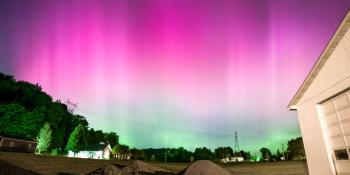Viewing archive of sobota, 5 kwietnia 2008
Raport aktywności słonecznej
Any mentioned solar flare in this report has a scaling factor applied by the Space Weather Prediction Center (SWPC). Because of the SWPC scaling factor, solar flares are reported as 42% smaller than for the science quality data. The scaling factor has been removed from our archived solar flare data to reflect the true physical units.
Raport aktywności słoneczno- geomagnetycznej 2008 Apr 05 2203 UTCPrzygotowane przez NOAA © SWPC i przetworzone przez SpaceWeatherLive.com
Połączenie raportów USAF/NOAA o słonecznej i geofizycznej aktywności
Numer SDF 096 wydany w 2200Z na 05 Apr 2008IA. Analiza aktywności regionów słonecznych i aktywność od 04-2100Z do 05-2100Z Solar activity was very low. Spotless plage Region 989
(S11W67) produced an isolated low-level B-class flare. SOHO/LASCO
images showed a halo CME, first visible in C2 at 05/1626Z. The CME
appeared to be from the back side, based on STEREO Ahead EUVI 195
images and the GOES- 10 X-ray signature. No new active regions were
numbered.
IB. Prognoza aktywności słonecznej
Solar activity is expected to be very
low.
IIA. Podsumowanie aktywności geofizycznej 04-2100Z do 05-2100Z
Geomagnetic field activity ranged from quiet to major storm levels
with a Kp = 6 observed during 05/1500 - 1800Z. ACE measurements
indicated Earth entered a fast solar wind flow from a recurrent
low-latitude coronal hole in the southern hemisphere. Solar wind
velocities increased during the period with a peak of 671 km/sec
detected at 05/1634Z. IMF Bz reached a minimum of -7 nT at 05/1441Z.
The greater than 2 MeV electron flux at geosynchronous orbit briefly
reached high levels during the period.
IIB. Prognoza aktywności geofizycznej
Geomagnetic field activity is
expected to be at unsettled to minor storm levels on day 1 (06
April) with major storm levels possible at high latitudes. Activity
is expected to decrease to unsettled to active levels during days 2
- 3 (07 - 08 April) as coronal hole effects persist.
III. Prawdopodobieństwa zdarzenia 06 Apr do 08 Apr
| Klasa M | 01% | 01% | 01% |
| Klasa X | 01% | 01% | 01% |
| Proton | 01% | 01% | 01% |
| PCAF | green | ||
IV. Przepływ 10,7 cm z Penticton
Zaobserwowano 05 Apr 071 Przewidywane 06 Apr-08 Apr 070/070/070 Średnia z 90 dni 05 Apr 073
V. Indeks geomagnetyczny A
Zaobserwowano Afr/Ap 04 Apr 008/011 Szacowane Afr/Ap 05 Apr 015/025 Przewidywane Afr/Ap 06 Apr-08 Apr 012/020-010/012-010/012
VI. Prawdopodobieństwa aktywności geomagnetycznej 06 Apr do 08 Apr
| A. Średnie szerokości geograficzne | |||
|---|---|---|---|
| Aktywne | 30% | 25% | 25% |
| Słaba burza | 10% | 05% | 05% |
| Bardzo znacząca burza | 01% | 01% | 01% |
| B. Wysokie szerokości geograficzne | |||
|---|---|---|---|
| Aktywne | 50% | 30% | 30% |
| Słaba burza | 25% | 10% | 10% |
| Bardzo znacząca burza | 05% | 01% | 01% |
All times in UTC
<< Idź do codziennego przeglądu
Najnowsze wiadomości
Najnowsze wiadomości z forum
What makes AR3684 magnetically distinct from AR3685? 6Filaments and prominences 129Latest SC25 Predictions 126Unproven theories 481AR3664 1072
Więcej tematówWesprzyj SpaceWeatherLive.com!
Wielu ludzi odwiedza SpaceWeatherLive aby śledzić aktywność słoneczną lub sprawdzić czy jest szansa na zaobserwowanie zorzy polarnej. Niestety, większy ruch na stronie oznacza większe koszty utrzymania serwera. Dlatego, jeśli jesteś zadowolony ze strony SpaceWeatherLive, zachęcamy do wspierania nas finansowo. Dzięki temu będziemy mogli utrzymać naszą stronę.

Fakty na temat pogody kosmicznej
| Ostatnie rozbłyski klasy X | 2024/05/15 | X2.9 |
| Ostatnie rozbłyski klasy M | 2024/05/17 | M7.1 |
| Ostatnia burza geomagnetyczna | 2024/05/17 | Kp6 (G2) |
| Spotless days | |
|---|---|
| Ostatni dzień bez skazy | 2022/06/08 |
| Monthly mean Sunspot Number | |
|---|---|
| kwietnia 2024 | 136.5 +31.6 |
| maja 2024 | 157.7 +21.2 |
| Last 30 days | 171.7 +57.7 |


